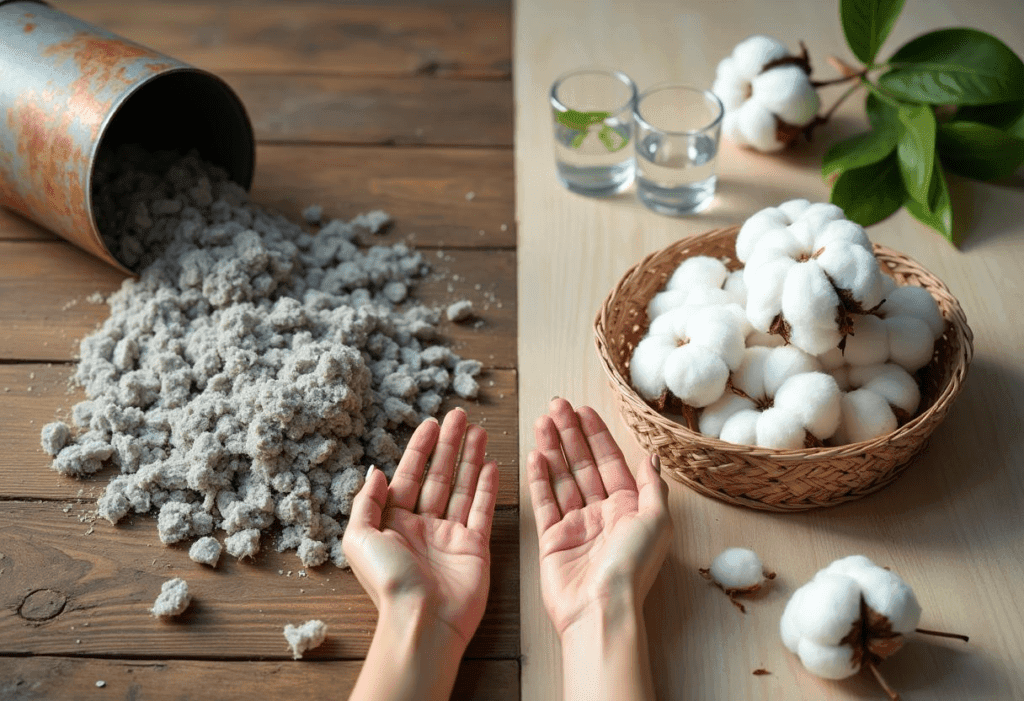The Shirt That Sparked a Question
Last month, I was hunting for a birthday gift for my dad when I stumbled on an organic cotton shirt. The label caught my eye—“eco-friendly, sustainably grown”—and I paused. What made this shirt greener than the stacks of tees in my closet growing up? I’ve always loved finding pieces that look good and feel right, especially for the men in my life—my brother, my partner, my dad—so I started digging into cotton’s story. Conventional cotton, I learned, is a thirsty, chemical-soaked giant, while organic cotton feels like Earth’s gentle rebel. I’m no farmer, but I’ve pored over stats, chatted with eco-friends, and styled these shirts enough to know there’s a difference. It’s huge, and it’s got me rethinking every thread. Ready to unearth how organic cotton slashes environmental harm compared to its conventional cousin? Let’s dig into the dirt and see what’s growing in 2025.
The Cotton Clash: A Tale of Two Fields
Cotton’s soft, sure, but its journey’s anything but fluffy. Here’s how I broke it down in my head:
- Conventional Cotton: The big kahuna—70% of global cotton, per the USDA. It’s grown with synthetic fertilizers, pesticides, and a water-guzzling appetite. Picture fields drenched in chemicals, soil gasping, and rivers running murky. It’s cheap and everywhere—think fast fashion tees—but the cost? It’s steep for the planet.
- Organic Cotton: The underdog, just 1% of production, but mighty. Grown without toxic pesticides or fertilizers, it leans on nature—compost, crop rotation, ladybugs instead of poison. It’s certified (like GOTS, my gold standard) to ensure no shortcuts. I see it as cotton with a conscience—cleaner, quieter, kinder.
The clash starts in the field. Conventional cotton’s a bully—pesticides kill bees, fertilizers choke waterways, and irrigation drains rivers dry. Organic cotton? It’s a nurturer—healthier soil, happier ecosystems, less waste. I couldn’t believe how stark the divide was until I saw the numbers. Let’s peel back the layers and count the wins.
Dirt, Water, and Air: Where Organic Shines
I’m no scientist, but the environmental perks of organic cotton hit me like a fresh breeze. Here’s how it stacks up, straight from my research rabbit hole:
- Soil Health: Conventional cotton sucks soil dry—synthetic fertilizers zap nutrients, leaving dirt brittle. The UN says 33% of global farmland’s degraded, partly from this. Organic cotton rebuilds soil with natural compost and rotation—25% more organic matter, per studies. I imagine fields thriving, not fading.
- Water Savings: Cotton’s thirsty—2,700 liters for one conventional shirt, says the WWF. Irrigation drains places like the Aral Sea (shrunk 90% since the ‘60s). Organic cotton cuts water use by 91% (Textile Exchange, 2020)—rain-fed or smarter systems mean rivers stay alive. That’s a shirt I’d gift without guilt.
- Chemical Cutback: Conventional cotton gulps 16% of global pesticides (FAO data)—toxic brews like aldicarb that poison workers and wildlife. Organic says no—zero synthetics, just natural pest control. I read that pesticide runoff kills 67 million birds yearly; organic’s a lifeline for them.
- Air Quality: Conventional’s fertilizers release nitrous oxide—a greenhouse gas 300 times worse than CO2. Organic skips that, slashing emissions by up to 46% (Soil Association). Cleaner air? Yes, please—I want my nephew breathing easy.
Every stitch counts. Conventional cotton’s a heavyweight polluter; organic’s a lightweight hero. I’ve seen shirts like these styled on my dad—soft, real, and proof of the difference.
Beyond the Field: The Ripple Effect
The impact doesn’t stop at harvest—I found ripples that reach further:
- Biodiversity Boost: Organic fields are havens—30% more species, from bees to birds, per the Organic Trade Association. Conventional’s monocultures? Dead zones. I love picturing wildlife buzzing around my brother’s shirt.
- Worker Wellness: Pesticides sicken 300,000 farmers yearly (WHO estimate)—conventional’s dark side. Organic protects them—no toxins, just dignity. I’d rather gift a shirt that doesn’t hurt hands.
- Durability Debate: Organic cotton’s often stronger—fewer chemicals mean tougher fibers. Conventional’s treated harsh, fraying fast. My dad’s organic tee’s outlasted his old ones—less waste, more wear.
- Carbon Footprint: Organic’s lighter—46% less CO2 than conventional (Textile Exchange). It’s not perfect (transport still counts), but it’s a start. I feel better knowing his wardrobe’s not overheating the planet.
These ripples hit home. Organic cotton’s not just a shirt—it’s a chain reaction of good.
Why It Matters in 2025: A Greener Closet Call
In 2025, cotton’s impact isn’t abstract—it’s urgent. Conventional cotton’s part of fashion’s $192 billion waste problem (Ellen MacArthur Foundation), choking landfills and rivers. Organic cotton’s a lifeline—1.5 million farmers grow it now, up 56% since 2016 (Textile Exchange), and demand’s spiking. I see it everywhere—brands proving eco can be everyday. For the men I shop for—my partner, my dad, my friends—I want shirts that don’t drown the Earth in toxins or trash. Organic’s not perfect (higher cost, lower yield), but it’s progress. Every swap’s a vote for cleaner fields, clearer waters, and a cooler planet.
Wrap-Up: Your Cotton Choice
Organic cotton’s my quiet hero—less harm, more hope than conventional’s messy reign. It’s not just fabric; it’s fields reborn, water saved, and air unpoisoned. Next time I’m picking a shirt, I’ll go organic—better for the planet, better for my conscience. Want to dig deeper? Check my GOTS certified picks or ethical fashion guide. Cotton’s story starts in the dirt—let’s make it a good one. What’ll you choose for your next gift—or your own threads?
